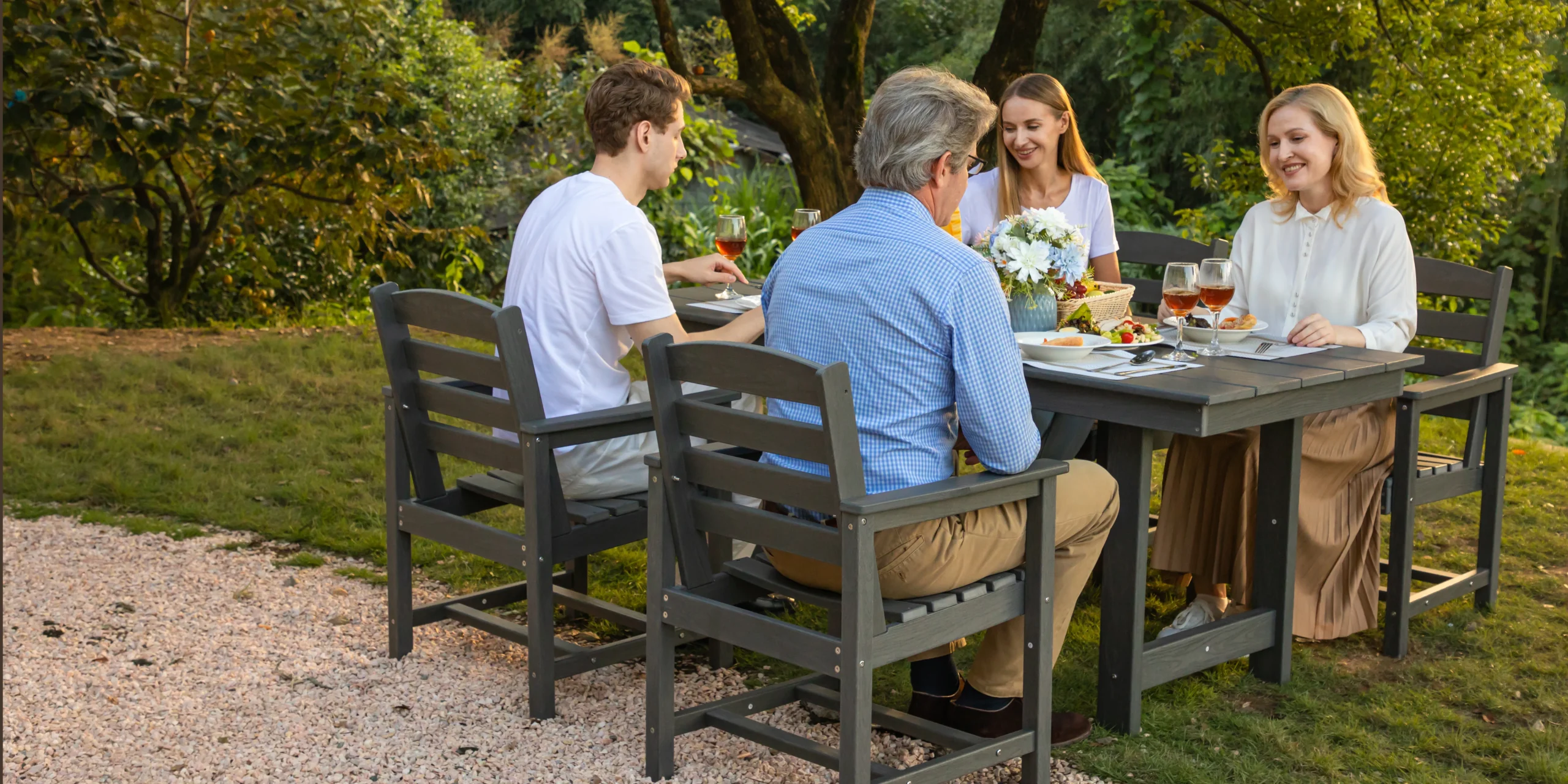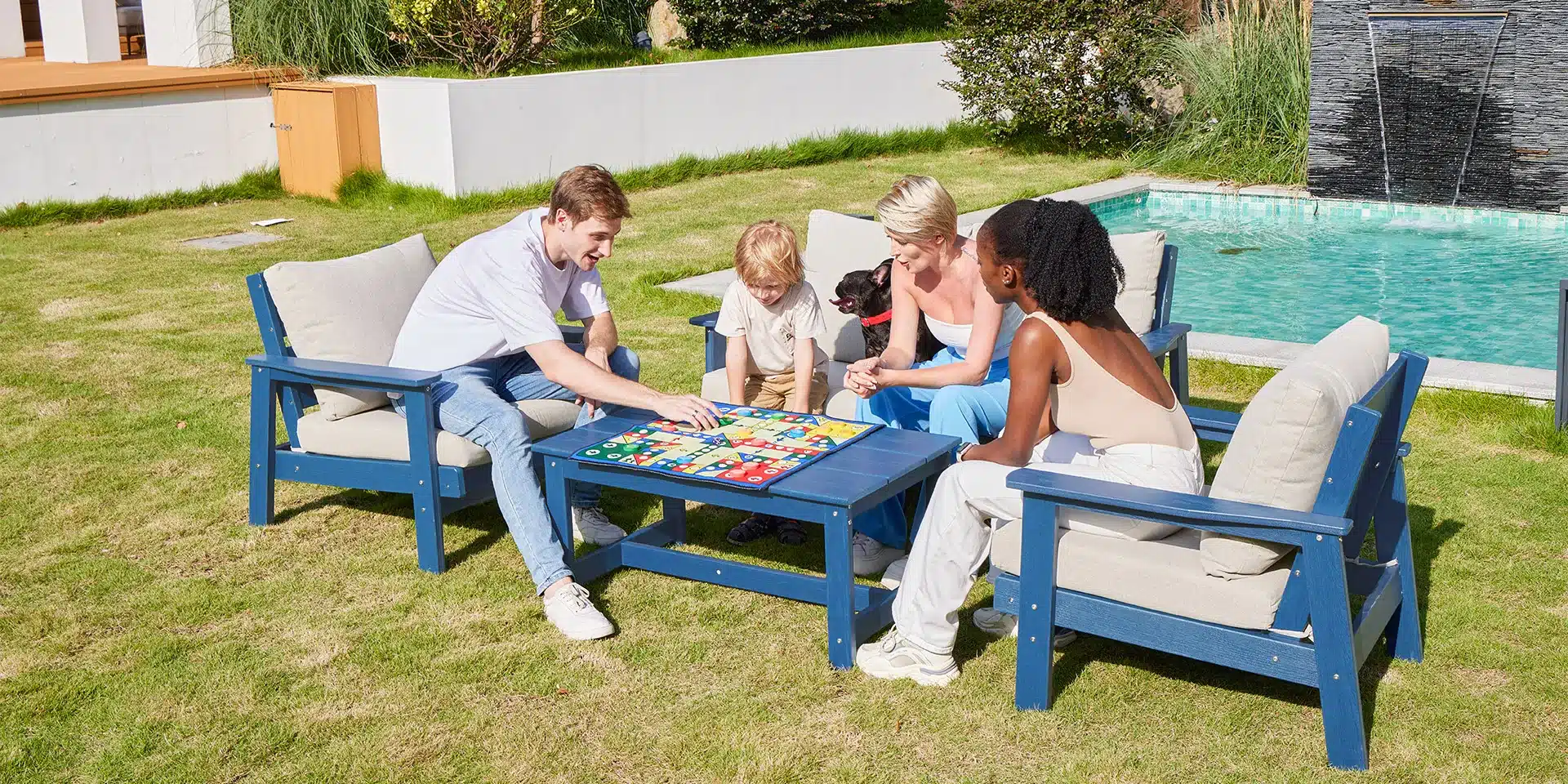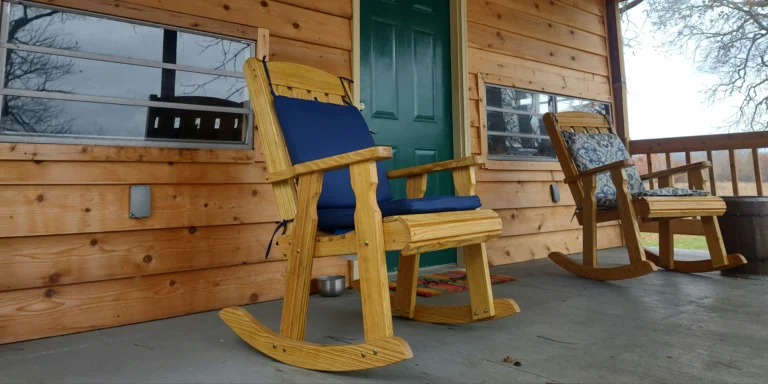In today’s society, the importance of sustainable development and environmental protection is increasingly valued. Increasingly, homeowners are incorporating eco-friendly concepts into their living spaces. If you want to do your part for the environment but don’t know where to start, why not start with your patio? Design an eco friendly patio to minimize your impact on the environment by using sustainable furniture materials, fabrics, or energy-efficient lighting, etc.
1. Choose Sustainable Patio Furniture Materials
Choosing outdoor furniture made from sustainable materials is a key step in creating an eco-friendly patio. Choose sustainable wood, recycled plastic, and other materials instead of wood to reduce your environmental impact. Here are some common recycled furniture materials:

Sustainable Wood
Examples include teak and cedar, which are FSC (Forest Stewardship Council) certified to ensure they come from sustainably managed forests. Rapidly renewable woods like bamboo are also great choices for eco-friendly furniture.
Recycled Plastic lumber
HDPE (High-Density Polyethylene): High-density polyethylene (HDPE) is a type of recycled plastic lumber made primarily from waste plastics like milk jugs, laundry detergent bottles, and shower gel bottles. HDPE is weather-resistant, fade-resistant, and low-maintenance, making it an ideal choice for an eco-friendly patio.
HIPS (High-Impact Polystyrene): HIPS is a recyclable material known for its excellent impact resistance and strength. It is typically made from recycled polystyrene, which includes materials such as disposable utensils, packaging foam, and casings from old electronic products. After being processed through recycling, HIPS is transformed into new products, reducing waste and minimizing the demand for new resources.
2. Choose Rcycled Fabrics and Textiles
When selecting outdoor eco-friendly fabrics, sustainability, durability, and comfort are essential factors. Next, we will recommend some ideal outdoor eco-friendly fabrics to help you create a beautiful and eco friendly patio.

Linen
Linen is a natural fiber that has a short growth cycle, which makes it eco-friendly. It offers excellent breathability and moisture-wicking properties, providing comfort in hot weather. Linen fabric is durable and becomes softer over time, making it suitable for outdoor cushions, curtains, or tablecloths.
Polyester
Recycled polyester is produced from plastic bottles, making it easy to maintain and resistant to wrinkles and UV exposure. It’s a great choice for outdoor cushions and decor, ensuring durability and aesthetic appeal.
Acrylic
Acrylic fabric is typically made from recycled materials and boasts excellent weather resistance and colorfastness, effectively withstanding sunlight and rain. It is ideal for making patio umbrellas, providing reliable protection for outdoor spaces.
3. Energy-Efficient Patio Lighting
When creating an eco friendly patio, outdoor energy-efficient lighting is also crucial. It can effectively reduce energy consumption and lower electricity costs. Meanwhile, good lighting design enhances safety and helps create a comfortable and inviting patio environment. The following energy-efficient lighting solutions can be adopted:

Solar Lighting
Utilizes solar panels to collect sunlight, automatically illuminating at night. It is both environmentally friendly and cost-effective, making it suitable for various outdoor settings.
Energy-Efficient LED
LED fixtures are highly efficient and have a long lifespan, significantly reducing energy consumption while generating less heat, making them ideal for extended use.
Smart Lighting
Controls the lighting system through smart timers or sensors, automatically adjusting light brightness and on/off times based on actual needs, further enhancing energy efficiency.
4. Save Water on Your Patio
Saving water is also an important way to create eco friendly patio. By selecting drought-tolerant plants, implementing rainwater collection systems or drip irrigation techniques, not only does it protect the environment, but it also reduces the cost and time of horticultural maintenance, ultimately improving the overall quality of life. This design makes our outdoor space more beautiful and sustainable.
Planting Drought-Tolerant Plants

By understanding the local rainfall, temperature, and soil type, you can select drought-tolerant plants that are suited to the climate while ensuring they coordinate with the existing landscape. Common drought-tolerant plants include succulents, lavender, and cacti.
Collecting Rainwater

Install rainwater collection barrels or tanks on the rooftop to store rainwater for irrigating plants and cleaning purposes. To improve collection efficiency, ensure that the tanks are properly connected to the roof drainage system to prevent clogs. Regularly check and clean the collection system to maintain good water quality.
Using Drip Irrigation Technology

Drip irrigation technology delivers water directly to the roots of plants, allowing for precise control over both the amount of water and the timing of irrigation. This method ensures that plants receive the necessary moisture for optimal growth while minimizing water loss due to evaporation from the soil surface.
5. DIY Patio Decorations
When creating an eco friendly patio, we can replace purchasing new decorations with reusing old items or DIY making. This method is environmentally friendly and creative, adding beauty to our living space and contributing to the protection of the earth.
Here are some decorative items you can create. Let’s get together and craft your own unique decorations!
Old Clothes Transformation
Choose some brightly colored or uniquely patterned old clothes or jeans, and cut them into a shape that fits the seat dimensions. Next, sew the edges of the fabric to create a closed cushion cover. Then, fill it with an appropriate amount of cotton, old fabric, or other soft materials, ensuring even distribution to avoid thick or thin spots. Finally, sew the opening shut to secure the cushion cover, making it both sturdy and aesthetically pleasing. This way, you can create a seat cushion that is both functional and full of personality.
DIY Handmade Wind Chime

First, gather the necessary materials, such as old glass bottles, wood, shells, and metal pieces, and clean and prepare them. Next, choose a sturdy base, like a wooden stick or metal ring, and use string or wire to hang the other materials from it. You can create either an orderly or a more casual layout. Once you ensure that each part is securely attached, hang the wind chime in an appropriate location, allowing it to sway freely and produce pleasant sounds.
DIY Pallet Sofa

First, choose sturdy pallets and sofa cushions suitable for outdoor use. Next, design a sofa frame based on the dimensions of your outdoor space by securing several pallets to create a stable seating structure. Then, use additional pallets as back support to ensure the sofa is comfortable and stable. Finally, enhance the softness of the sofa by adding outdoor cushions, and consider pairing it with throw pillows or blankets for added comfort.
DIY pallet sofas not only save money, but also fully showcase personal style in decoration, creating a unique outdoor space.
6. Turning Trash into Compost
In patio gardening, using compost is an effective environmental strategy to reduce the use of disposable plastics. By converting kitchen waste, gardening residues, and other organic materials into nutrient-rich compost, the production of plastic waste can be reduced and soil quality can be improved.

Here are the steps to make patio compost:
- Choose a Compost Container: Select a suitable compost container for your terrace, such as a dedicated compost bin, a plastic bucket, or a homemade wooden box. Make sure the container has ventilation holes to promote air circulation.
- Collect Compost Materials: Gather compostable organic materials, including:a. Green Materials: Fresh fruit and vegetable scraps, coffee grounds, and other nitrogen-rich items.b. Brown Materials: Dried leaves, paper scraps, straw, and other carbon-rich materials. Avoid using meat, dairy products, and oils, as these can attract pests and create unpleasant odors.
- Layer the Compost: Place a layer of coarse materials (like branches or straw) at the bottom of the container, then alternate adding green and brown materials to create layers. Aim for a ratio of approximately 2:1 (more brown materials than green).
- Maintain Moisture: Ensure the compost remains moderately moist but not overly wet. You can adjust the moisture level by spraying water or adding water during dry spells.
- Turn the Compost Regularly: Every few weeks, use a shovel to turn the compost, increasing airflow and helping to accelerate the decomposition process. This also prevents odors and maintains good aeration.
- Observe and Wait: Keep an eye on the compost’s progress, which typically takes several months to a year to fully decompose. Mature compost will appear dark brown, crumbly, and have a fresh scent.
- Use the Compost: Once the compost is complete, you can use it to improve the soil quality and provide nutrients for your terrace plants.
7. Maintain Sustainable Lifestyles
The concept of sustainability and environmental protection should not only be reflected in decor but also integrated into our daily lives. We can engage in eco-friendly activities on the patio to set a good example for our family and children, contributing to the protection of our planet.

Host Eco-Friendly Party
You can organize an environmentally themed party on each International Environmental Protection Day, inviting friends and family to join. Everyone can share their experiences with sustainable living, discuss environmental issues, and encourage each other to engage in eco-friendly activities, such as participating in community clean-ups or tree planting.
During the gathering, we should pay attention to the amount of food prepared to minimize leftovers. Communicating with participants in advance to understand their dietary needs can help with proper planning. Additionally, providing sustainable utensils, such as reusable or biodegradable ones, will help avoid the use of single-use plastics.
Join the Plastic-Free Challenge
You can also initiate a plastic-free challenge on your patio. Start by organizing all the plastic items and identifying which ones are single-use or unnecessary. Then, invite your family to participate and encourage them to find alternative materials. Next, hold a replacement competition to see who can swap out the most plastic items.
Once the replacements are complete, gather together to share experiences and discuss effective alternatives, as well as ways to further reduce plastic use in daily life. Finally, engage in a discussion about sustainable living, exploring other eco-friendly actions to enhance everyone’s environmental awareness.





